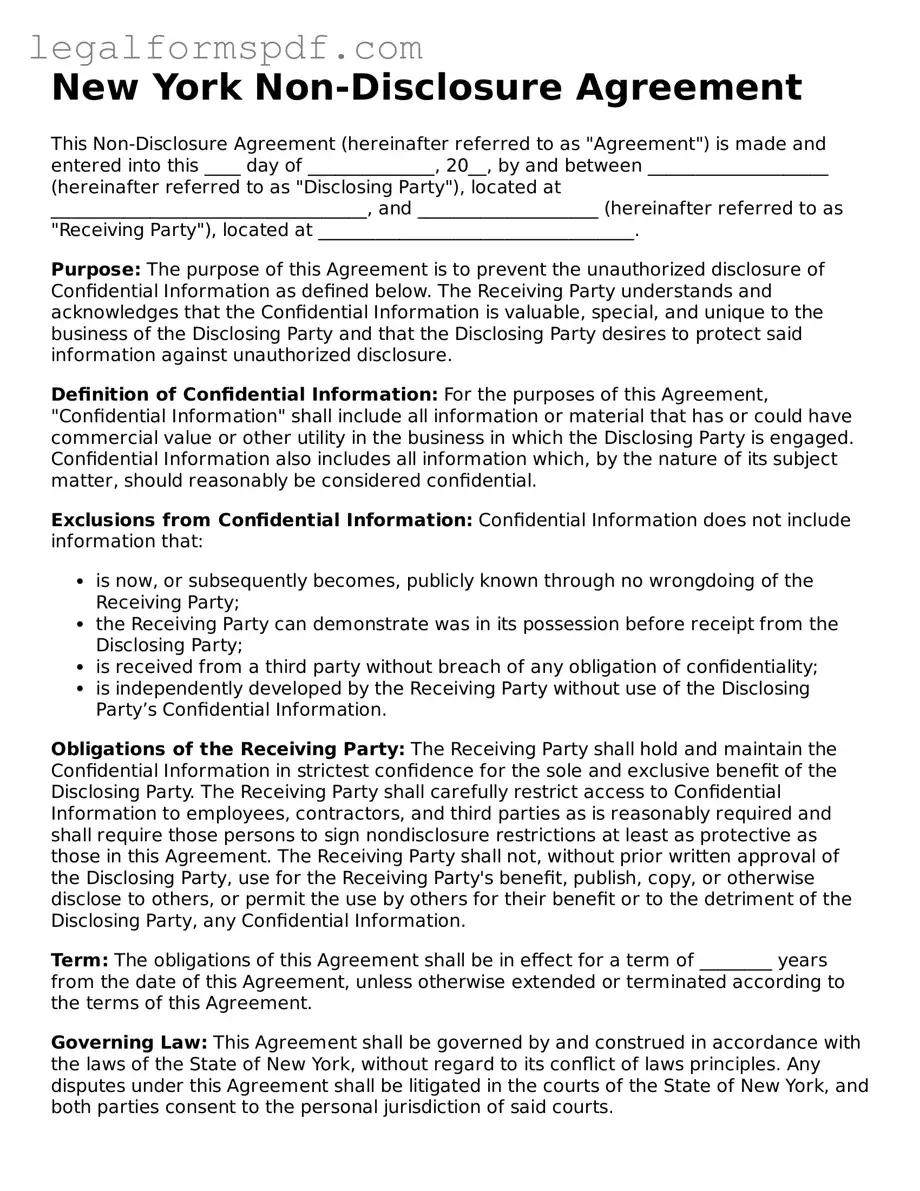New York Non-Disclosure Agreement
This Non-Disclosure Agreement (hereinafter referred to as "Agreement") is made and entered into this ____ day of ______________, 20__, by and between ____________________ (hereinafter referred to as "Disclosing Party"), located at ___________________________________, and ____________________ (hereinafter referred to as "Receiving Party"), located at ___________________________________.
Purpose: The purpose of this Agreement is to prevent the unauthorized disclosure of Confidential Information as defined below. The Receiving Party understands and acknowledges that the Confidential Information is valuable, special, and unique to the business of the Disclosing Party and that the Disclosing Party desires to protect said information against unauthorized disclosure.
Definition of Confidential Information: For the purposes of this Agreement, "Confidential Information" shall include all information or material that has or could have commercial value or other utility in the business in which the Disclosing Party is engaged. Confidential Information also includes all information which, by the nature of its subject matter, should reasonably be considered confidential.
Exclusions from Confidential Information: Confidential Information does not include information that:
- is now, or subsequently becomes, publicly known through no wrongdoing of the Receiving Party;
- the Receiving Party can demonstrate was in its possession before receipt from the Disclosing Party;
- is received from a third party without breach of any obligation of confidentiality;
- is independently developed by the Receiving Party without use of the Disclosing Party’s Confidential Information.
Obligations of the Receiving Party: The Receiving Party shall hold and maintain the Confidential Information in strictest confidence for the sole and exclusive benefit of the Disclosing Party. The Receiving Party shall carefully restrict access to Confidential Information to employees, contractors, and third parties as is reasonably required and shall require those persons to sign nondisclosure restrictions at least as protective as those in this Agreement. The Receiving Party shall not, without prior written approval of the Disclosing Party, use for the Receiving Party's benefit, publish, copy, or otherwise disclose to others, or permit the use by others for their benefit or to the detriment of the Disclosing Party, any Confidential Information.
Term: The obligations of this Agreement shall be in effect for a term of ________ years from the date of this Agreement, unless otherwise extended or terminated according to the terms of this Agreement.
Governing Law: This Agreement shall be governed by and construed in accordance with the laws of the State of New York, without regard to its conflict of laws principles. Any disputes under this Agreement shall be litigated in the courts of the State of New York, and both parties consent to the personal jurisdiction of said courts.
Entire Agreement: This Agreement constitutes the entire agreement between the parties concerning the subject matter hereof and supersedes all previous agreements, whether written or oral, concerning this subject matter. Any amendments or modifications to this Agreement must be in writing and signed by both parties.
In Witness Whereof, the parties have executed this Agreement as of the date first above written.
_________________________________
Signature of Disclosing Party
Name: _____________________________
Title: ______________________________
Date: ______________________________
_________________________________
Signature of Receiving Party
Name: ______________________________
Title: _______________________________
Date: _______________________________
